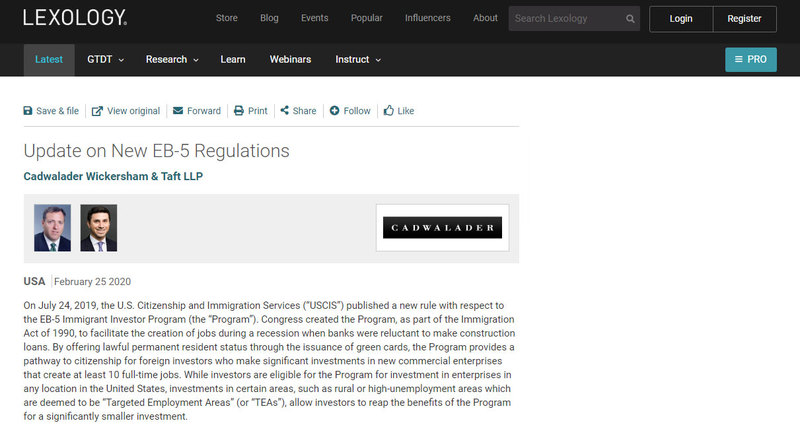On July 24, 2019, the U.S. Citizenship and Immigration Services (“USCIS”) published a new rule with respect to the EB-5 Immigrant Investor Program (the “Program”). Congress created the Program, as part of the Immigration Act of 1990, to facilitate the creation of jobs during a recession when banks were reluctant to make construction loans. By offering lawful permanent resident status through the issuance of green cards, the Program provides a pathway to citizenship for foreign investors who make significant investments in new commercial enterprises that create at least 10 full-time jobs. While investors are eligible for the Program for investment in enterprises in any location in the United States, investments in certain areas, such as rural or high-unemployment areas which are deemed to be “Targeted Employment Areas” (or “TEAs”), allow investors to reap the benefits of the Program for a significantly smaller investment.
Investments of capital into a new commercial enterprise can be made either as an equity purchase or a loan. In the equity purchase option, which is the simpler option, the investor contributes capital directly into the job-creating project and, in turn, becomes an equity owner of the project. The loan option, however, necessitates an additional step because the USCIS requires that the investor’s money be “at risk” throughout the immigration process and, therefore, the capital must be initially provided as equity, and not as a loan, to the job-creating project. To satisfy this requirement, the investor makes an equity contribution to an EB-5 fund, which, in turn, lends the money to the job-creating project. Although more cumbersome, the loan option is the preferred option of most investors as it offers a clear path to exit at the time of the loan’s maturity.
Although critics, citing widespread abuse and allegations of gerrymandering of TEAs, have advocated for change to the Program for many years, the new rule is the first significant revision to the Program since 1993. In an effort to allow for a more fair and consistent process, and to alleviate the risk of gerrymandering, the USCIS eliminated states’ ability to designate certain geographic subdivisions as high unemployment areas. Instead, the Department of Homeland Security (of which USCIS is a part) will be the sole decision-maker as to the designation of TEAs and will follow a uniform but more strict standard. More importantly, however, the new rule raises the threshold investment amount needed to qualify for the Program by 80%. Previously, to be eligible for a green card, applicants were required to invest either $1,000,000 in a non-needy area or $500,000 in a TEA. Under the new rule, the minimum requirement was increased to reflect the rate of inflation since the Program’s creation in 1990 to $1,800,000 for a non-needy area and $900,000 for a TEA, with such amounts automatically adjusting for inflation every five years.
As the new rule went into effect on November 21, 2019, we can’t yet be certain how it will affect the market. However, the new standards for TEAs will likely reduce the number of eligible projects in major metropolitan markets, and the new threshold amount will require developers to work harder to raise capital from a smaller pool of investors who can afford to make the larger investment. Foreign investors may divert funds to other countries with less stringent investment requirements. As this source of alternative lending may dry up, developers may need to turn to more traditional lending sources to fund larger portions of their projects. Banks may need to decide if they are willing to increase leverage, and developers may be forced to inject more equity into their projects.
Despite these new hurdles, many industry analysts believe that the market will absorb the price increase. Over the past number of years, demand for the EB-5 visas has far exceeded the yearly allocation, and as such, a decrease in the number of applicants may not cause a decrease in overall investment. With the increased investment threshold, developers can raise the same amount of capital they previously raised, but from fewer investors. While the increased investment threshold and stricter designation guidelines will surely keep some investors from taking advantage of the Program, only time will tell if these changes will be beneficial or cause a widespread change to funding in the market.
https://www.lexology.com/library/detail.aspx?g=0f64b70b-d04a-4e8d-9540-e371060f99d1
Mentions
States
- New York
Securities Disclaimer
This website is for informational purposes only and does not constitute an offer or solicitation to sell shares or securities. Any such offer or solicitation will be made only by means of an investment's confidential Offering Memorandum and in accordance with the terms of all applicable securities and other laws. This website does not constitute or form part of, and should not be construed as, any offer for sale or subscription of, or any invitation to offer to buy or subscribe for, any securities, nor should it or any part of it form the basis of, or be relied on in any connection with, any contract or commitment whatsoever. EB5Projects.com LLC and its affiliates expressly disclaim any and all responsibility for any direct or consequential loss or damage of any kind whatsoever arising directly or indirectly from: (i) reliance on any information contained in the website, (ii) any error, omission or inaccuracy in any such information or (iii) any action resulting therefrom.




